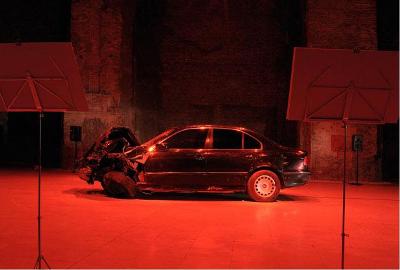
Hajnal Németh: Crash - Passive Interview. Photo: Tihanyi-Bakos Photo Studio, Museum Kiscell – Municipal Picture Gallery, Budapest, 2010.
Hungarian Pavilion
54th International Art Exhibition – La Biennale di Venezia
Hajnal Németh
Crash - Passive Interview
Curator: Miklós Peternák
Commissioner: Gábor Gulyás
54th International Art Exhibition
La Biennale di Venezia 2011
Giardini, Venice
4 June−27 November 2011
Pavilion Opening:
2nd June 2011 at 6.15 pm
Opening address: Prof. Dr. Hubertus von Amelunxen
Preview: 1−3 June 2011
www.crash-passiveinterview.c3.hu
Object installation, video and audio installation featuring an experimental opera in 12 acts
Collaborators: Xenia Romashova (soprano), Jana Kurucová (mezzo), Susanne Gritschneder (alto), Gregory Warren (tenor), Nathan De'Shon Myers (baritone), Tomasz Wija (bass), Matthias Samuil (piano), Virginia Ehrhardt (piano), David Sills (cello), Kinderchor Canzonetta Berlin (singing), Jochen Wittur (choir leader), Reggie Moore (music)
István Imreh (camera), Volker Schaner and Dino Grobe - Fufoo Film GmbH (audio recording), Yensin Jahn, Studios P4 Berlin (audio recording)
Hajnal Németh's installation "Crash – Passive Interview" will be on show in the Hungarian Pavilion at the 54th International Art Exhibition of the Venice Biennale in 2011.
The skeleton of the work is an experimental opera that takes place on the stage of life, relating, and reflecting on the stories of car crashes in a dialogical form: the critical moment slowed down by memory and recounted in utmost detail; the drive and the course of events leading up to that moment; as well as the complex relation of man to driving, in view of his inclination to fetishize his technical objects.
Filling the space as an acoustic experience, the piece will also be presented at the show in the form of a musical film.
The installation is complemented with the librettos of the dialogues, namely the written records of the passive interviews, as well as the real life wreck of a car totalled in a crash, which occupies the space as an evocative artefact. Beyond the individual events that are recorded, sung, or impressed in a chassis, the composed versions of individual life stories suggest the possibility of determinacy with regard to human destiny.
"The sight of a totalled car is indeed shocking, as the energy of the crash is imprinted in its shape, its creases and distortions. Most of us are probably interested in the underlying story: how did the accident happen, did they survive?
Related by a survivor, the catastrophic moment is slowed down by memory to an extremity of the most minuscule detail, going back to the very beginning of the notable day even, as if he were exploring the relation of cause and effect, his decisions that eventually and irrevocably led to the crash. In this slow replay, I perceive the very relief of the shock, the "comforting" explanation for the unavoidable crash. The fact that the outcome of this story is predetermined—as indicated by the yes-no questions of the sung inner monologues—is far from comforting, though. The opera genre is intended to convey this tension. The story begins at a car factory, and thus the story of the car, that is, its "life", which is ended by the crash, ironically takes the place of human life at some points."
The curator, Miklós Peternák is the director of C3 – Center for Culture and Communication since 1997 and the Head of the Intermedia Department at the Hungarian University of Fine Arts. The Műcsarnok Kunsthalle is the responsable of the Hungarian representation in the Biennale.
Sponsorship and Support:
The Hungarian Pavilion at the Venice Biennale is financed by the Ministry of National Resources and the National Cultural Fund of Hungary and sponsored by the C3 - Center for Culture & Communication Foundation, FuFoo Film GmbH, ADAM Audio, Precise Myer's Hotel Berlin.
organization: Műcsarnok Kunsthalle Budapest
Biennale office: Júlia Gáspár
Further information:
email:
biennaleoffice@mucsarnok.hu
www.velenceibiennale.com
www.labiennale.org
www.hajnalnemeth.com


